In Which Gothic Cathedral Were Flying Buttresses Used For The First Time?
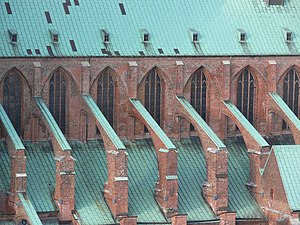
The flying buttress ( arc-boutant , curvation buttress) is a specific course of buttress composed of an curvation that extends from the upper portion of a wall to a pier of great mass, in order to convey to the ground the lateral forces that push a wall outwards, which are forces that arise from vaulted ceilings of stone and from air current-loading on roofs.[i]
The defining, functional characteristic of a flying buttress is that it is not in contact with the wall at footing level, unlike a traditional buttress, and and then transmits the lateral forces across the bridge of intervening infinite between the wall and the pier. To provide lateral support, flying-buttress systems are equanimous of ii parts: (i) a massive pier, a vertical block of masonry situated away from the building wall, and (ii) an arch that bridges the span between the pier and the wall — either a segmental curvation or a quadrant arch — the flyer of the flight buttress.[2]
History [edit]

Equally a lateral-back up arrangement, the flying buttress was adult during late antiquity and subsequently flourished during the Gothic period (12th–16th c.) of architecture. Ancient examples of the flying buttress can be found on the Basilica of San Vitale in Ravenna and on the Rotunda of Galerius in Thessaloniki. The architectural-chemical element precursors of the medieval flying buttress derive from Byzantine architecture and Romanesque architecture, in the design of churches, such as Durham Cathedral, where arches transmit the lateral thrust of the stone vault over the aisles; the arches were hidden under the gallery roof, and transmitted the lateral forces to the massive, outer walls. By the decade of 1160, architects in the Île-de-French republic region employed similar lateral-back up systems that featured longer arches of finer design, which run from the outer surface of the clerestory wall, over the roof of the side aisles (hence are visible from the outside) to meet a heavy, vertical buttress rising to a higher place the top of the outer wall.[3]
The flying buttresses of Notre Matriarch de Paris, synthetic in 1180, were among the earliest to exist used in a Gothic cathedral. Flying buttresses were likewise used at well-nigh the same time to back up the upper walls of the apse at the Church building of Saint-Germain-des-Prés, completed in 1163. [iv]
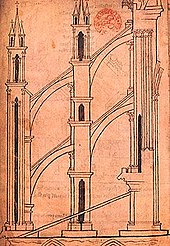
The reward of such lateral-support systems is that the outer walls exercise not have to be massive and heavy in order to resist the lateral-strength thrusts of the vault. Instead, the wall surface could be reduced (allowing for larger windows, glazed with stained drinking glass) because the vertical mass is concentrated onto external buttresses. The design of early flying buttresses tended to exist heavier than required for the static loads to be borne, e.m. at Chartres Cathedral (ca. 1210), and around the alcove of the Saint Remi Basilica, which is an extant, early on example in its original form (ca. 1170).[five] Later on architects progressively refined the blueprint of the flying buttress, and narrowed the flyers, some of which were synthetic with one thickness of voussoir (wedge brick) with a capping rock atop, e.g. at Amiens Cathedral, Le Mans Cathedral, and Beauvais Cathedral.
The architectural blueprint of Late Gothic buildings featured flying buttresses, some of which included flyers decorated with crockets (hooked decorations) and sculpted figures set in aedicules (niches) recessed into the buttresses. In the event, the architecture of the Renaissance eschewed the lateral support of the flying buttress in favour of thick-wall construction. Despite its disuse for function and style in construction and architecture, in the early 20th century, the flying-buttress pattern was revived by Canadian engineer William P. Anderson to build lighthouses.[half dozen]
Construction [edit]

Given that most of the weight-load is transmitted from the ceiling through the upper part of the walls, the flying buttress is a 2-role composite back up that features a semi-arch that extends to a massive pier far from the wall, and and so provides most of the load-bearing capacity of a traditional buttress, which is engaged with the wall from top to bottom; thus, the flying buttress is a lighter and more toll-effective architectural structure.
By relieving the load-bearing walls of excess weight and thickness, in the way of a smaller area of contact, using flying buttresses enables installing windows in a greater wall surface area. This feature and a desire to allow in more light, led to flight buttresses becoming i of the defining factors of medieval Gothic architecture and a feature used extensively in the design of churches from and so and onwards. In the blueprint of Gothic churches, two arched flyers were applied, one higher up the other, in which the lower flyer (positioned beneath the springing indicate of the vault) resists the lateral-thrust forces of the vault, whilst the upper flyer resists the forces of air current-loading on the roof.[seven] The vertical buttresses (piers) at the outer end of the flyers usually were capped with a meridian (either a cone or a pyramid) unremarkably ornamented with crockets, to provide additional vertical-load support with which to resist the lateral thrust conveyed by the flyer.[8]

A flight buttress as remedial support for a church wall in the English hamlet of Chaddesley Corbett
To build the flying buttress, it was first necessary to construct temporary wooden frames, which are chosen centring. The centering would back up the weight of the stones and help maintain the shape of the arch until the mortar was cured. The centering was beginning built on the footing, by the carpenters. Once that was done, they would exist hoisted into identify and fastened to the piers at the end of one buttress and at the other. These acted every bit temporary flight buttresses until the actual, rock arch was consummate.[9]
- Remedial back up awarding
Some other awarding of the flying-buttress support system is the reinforcement of a leaning wall in danger of collapsing, especially a load-bearing wall; for instance, at the village of Chaddesley Corbett in Worcestershire, England, the practical awarding of a flight buttress to a buckled wall was more practical than dismantling and rebuilding the wall.
Aesthetic style of the Gothic period [edit]
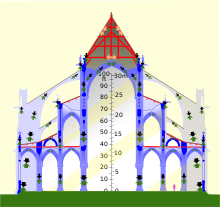
The early-Gothic Notre-Dame de Paris (shown hither with buttresses every bit later modified) features flying buttresses with blocky porticoed pinnacles, surrounding a alpine nave, a clerestory, a wide triforium, and 2 side aisles. Arrows show structural forces (details)
The desire to build large cathedrals that could business firm many followers forth multiple aisles arose, and from this desire the Gothic style developed.[10] The flight buttress was the solution to these massive stone buildings that needed a lot of support but were expansive in size. Although the flight buttress originally served a structural purpose, they are now a staple in the aesthetic style of the Gothic period.[11] The flying buttress originally helped bring the idea of open up space and lite to the cathedrals through stability and structure, by supporting the clerestory and the weight of the high roofs.[11] The acme of the cathedrals and ample amount of windows among the clerestory creates this open infinite for viewers to see through, making the space appear more continuous and giving the illusion of in that location beingness no clear boundaries.[11]
It besides makes the infinite more dynamic and less static separating the Gothic style from the flatter, more two dimensional, Romanesque way.[11] After the introduction of the flight buttress this same concept could be seen on the outside of the cathedrals as well.[11] There is open space below the arches of the flying buttress and this infinite has the same event as the clerestory within the church building allowing the viewer to view through the arches, the buttresses also reach into the sky similar to the pillars inside the church which creates more upward space,[11] making the exterior space equally as dynamic as the interior space and creating a sense of coherence and continuity.[12]
Gallery of flight buttresses [edit]
-

-

Notre Dame of Paris
-
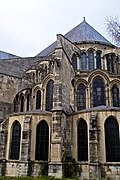
In the basilica built ca. AD 1170 at the Abbey of Saint-Remi, in France a flight buttress organisation is used for lateral-back up
-

-

Saint-Petrus-en-Pauluskerk, Ostend, Kingdom of belgium
-
-

-

-

-
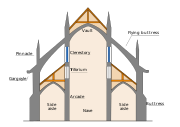
Flying buttresses in cantankerous-section
In fiction [edit]
The compages and structure of a medieval cathedral with flying buttresses figures prominently into the plot of the historical novel The Pillars of the Globe by Ken Follett (1989).
See also [edit]
- Buttress
- Cathedral architecture
- Flying arch
- Gothic architecture
- Seismic retrofit
Notes [edit]
- ^ Curls, James Stevens, ed. (1999). A Dictionary of Architecture. Oxford. pp. 113–114.
- ^ For the functional mechanics of the flying buttresses, see Borg, Alan; Marker, Robert (1973). "Chartres Cathedral: A Reinterpretation of its Construction". The Art Message. 55 (three): 367–372. doi:10.1080/00043079.1973.10790710.
- ^ James, John (September 1992). "Evidence for flight buttresses before 1180". J. Soc. Archit. Hist. 51 (3): 261–287. doi:10.2307/990687.
- ^ Watkin, David, "A History of Western Architecture" (1986), page 130
- ^ Prache, Anne (1976). "Les Arcs - boutants au XIIe siècle". Gesta. 15 (1): 31–42. doi:10.2307/766749.
- ^ Rowlett, Russ. "Canadian Flying Buttress Lighthouses". The Lighthouse Directory. Academy of Due north Carolina at Chapel Colina.
- ^ Marker, R.; Jonash, R. Due south. (1970). "Wind Loads on Gothic Structures". Journal of the Guild of Architectural Historians. 29 (iii): 222–230. doi:10.2307/988611.
- ^ Curls, James Stevens, ed. (1999). A Lexicon of Architecture. Oxford. p. 501.
- ^ Alex Lee, James Arndt, and Shane Goldmacher, Cathedral Compages Archived 2005-08-29 at the Wayback Motorcar.
- ^ Moore, Charles H. (1979). Development + & and grapheme of gothic architecture. Longwood. pp. nineteen-twenty. ISBN0893413585. OCLC 632226040.
- ^ a b c d e f Frankl, Paul (1962). Gothic Architecture. Baltimore: Penguin Books. pp. 54–57.
- ^ Mark, Robert (2014). Experiments in Gothic Structure. Bibliotheque McLean. ISBN0955886864. OCLC 869186029.
References [edit]
- Watkin, David (1986). A History of Western Compages. Barrie and Jenkins. ISBN0-7126-1279-iii.
- Chisholm, Hugh, ed. (1911). . Encyclopædia Britannica (11th ed.). Cambridge University Press.
In Which Gothic Cathedral Were Flying Buttresses Used For The First Time?,
Source: https://en.wikipedia.org/wiki/Flying_buttress
Posted by: williamsyestan73.blogspot.com

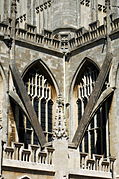

0 Response to "In Which Gothic Cathedral Were Flying Buttresses Used For The First Time?"
Post a Comment